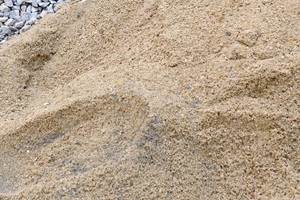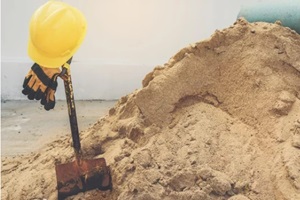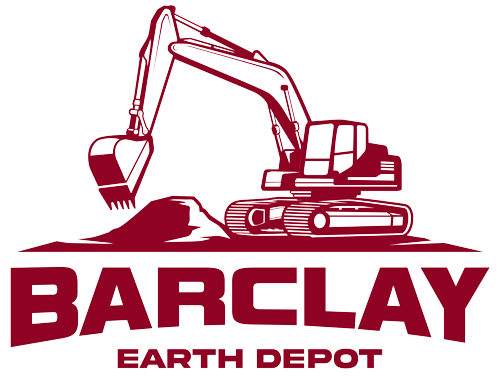 Concrete sand is the most ubiquitous building material used in construction projects of all scales. From massive infrastructure projects such as bridges and dams to small backyard patios, this composite material built from cement, aggregates, water, and other ingredients is found everywhere.
Concrete sand is the most ubiquitous building material used in construction projects of all scales. From massive infrastructure projects such as bridges and dams to small backyard patios, this composite material built from cement, aggregates, water, and other ingredients is found everywhere.
One of the main elements that gives concrete its strength, durability, and finish quality is sand. However, not all sands perform the same in concrete.
Selecting the optimal construction sand for concrete applications is essential for success.
What to Look for in Concrete Sand
When selecting sand for concrete, you’ll want to keep an eye out for qualifiers such as:
Particle Size Distribution
Sand used in concrete needs to have an appropriate gradation, which refers to the distribution of differently-sized grains. Well-graded sand has a good distribution of coarse and fine particles.
This blend allows for dense compaction and fewer voids, translating into greater strength. Extremely fine sands can make concrete mixes more workable but may weaken ultimate strength.
Particle Shape
The shape of sand grains impacts concrete properties significantly. Angular and rough particles with fractured faces create better adhesion in the concrete matrix and improve strength.
Smooth, rounded grains found in beach and river sands sound appealing but actually make concrete weaker and less durable as they have less interlocking ability within the cement paste.
Cleanliness
Concrete sand needs to be free from clay, silt, and organic impurities which can interfere with bonding. Salts and contaminants can also adversely react with concrete elements leading to issues such as efflorescence or scaling. Clean sand meeting specifications such as ASTM C33 provides optimal concrete integrity.
Gradation Consistency
Different concrete applications call for specific sand gradations. Blindly following bag labels doesn’t guarantee suitable performance. For example, concrete going into small decorative projects needs properly graded fine sand.
Structural concrete may use a coarser blend. Avoid mixes with particles concentrated only in certain size ranges and ask suppliers for current sieve testing.
Cement Compatibility
While cement chemically reacts with water during curing, aggregates such as sand function in an important role affecting the concrete’s structural formation.
Incompatible sands containing deleterious substances may negatively impact this process and the quality of your finished concrete. Reputable suppliers will gladly share compatibility data.
Moisture Content
 Sand grains naturally absorb ambient moisture to varying degrees depending on their composition. Batch consistency is essential for concrete quality as excess water impacts strength and curing; therefore, concrete sand kept stockpiled should have consistent moisture content in the 3 to 6 percent range when batched. Higher moisture requires adjustments to the amount of water that will be added to the mix.
Sand grains naturally absorb ambient moisture to varying degrees depending on their composition. Batch consistency is essential for concrete quality as excess water impacts strength and curing; therefore, concrete sand kept stockpiled should have consistent moisture content in the 3 to 6 percent range when batched. Higher moisture requires adjustments to the amount of water that will be added to the mix.
Additives
In certain applications, specialty sands incorporate resins, quartz, coloring, or other additives to achieve specific performance goals.
These sands obviously cost more than natural concrete blends but deliver enhanced qualities. Make sure you understand exactly why they are needed for your particular project.
Sustainable Sourcing
Specifiers and regulators increasingly consider the environmental impacts of material harvesting and transportation distances.
Locally sourced concrete sands significantly reduce the overall carbon footprint of projects and support regional economic development, a factor that may one day be mandated through building codes.
Top Testing Criteria for Assessing Concrete Sand Quality
When it comes to making sure your construction sand for concrete is high quality, there are a few key lab tests that technicians use to analyze important performance factors.
- Gradation Consistency – A sieve analysis is fundamental for validating the consistent distribution of grain sizes with comparison to an ideal reference curve. Variations must fall within accepted tolerances.
- Shape Characteristics – Under a microscope, sand particles should exhibit rough, irregular, and angular characteristics with few smooth or rounded grains. More fractured faces improve bonding ability.
- Organic Impurity Test – A simple colorimetric test detects the presence of harmful organic compounds such as humus, decayed vegetation, or wood that negatively impact strength.
- Sand Equivalent Test – This indicates the proportions of fine dust particles that don’t contribute to concrete strength. Higher sand equivalent numbers are best.
- Chemical Reactivity Tests – Various tests help determine the potential for sand aggregates to react adversely with cement paste or be susceptible to environmental factors such as water intrusion sensitivity.
Sampling Concrete Sand Appropriately
Gradations and characteristics can vary significantly even within the same sand deposit or delivery truck. Consistent sampling is key:
 Pull samples from multiple levels and areas of stockpiles after remixing the entire volume with front loaders.
Pull samples from multiple levels and areas of stockpiles after remixing the entire volume with front loaders.- For delivered sand, take smaller samples from multiple spots of the truck bed or conveyor belt stream during unloading.
- Combine samples in clean pails, mixing thoroughly. Take your test sample from this representative blend.
- Ask the driver for load tickets indicating the source quarry or harvest site and recent sieve analysis data.
- Send one sealed sample to an accredited lab while performing basic tests on your duplicate.
Source Top Quality Florida Construction Sand from Barclay Earth Depot
In commercial construction, failure to meet quality standards could mean extensive repairs, costly litigation, or worse. When used in concrete, construction sand can make or break the quality of the concrete and the project.
With an extensive inventory of construction, fill, and landscape sands, Barclay Earth Depot has served Fort Myers builders for years. Contact us today at 941.841.1681 or online for quality construction sand that will ensure your projects stand the test of time.

